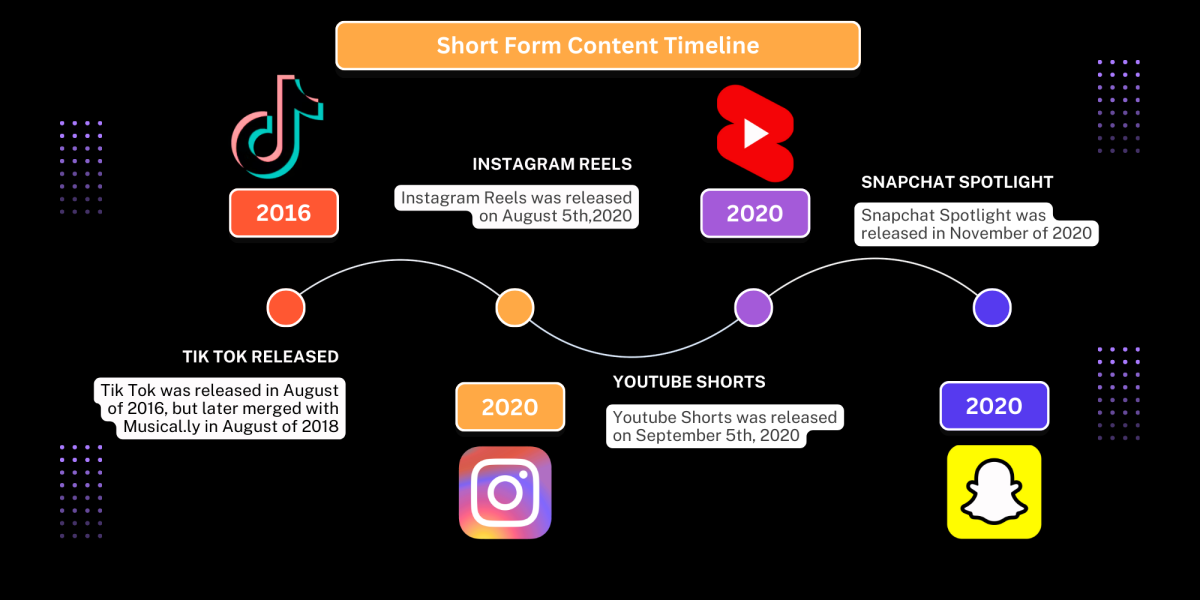In today’s modern world, digital media consumption is at an all-time high. From music to video games, podcasts to TV shows, it’s everywhere in our lives. However, one form of content has emerged and proven to be the big dominant force in the way we consume information today: short form content. From YouTube Shorts to Instagram Reels, it seems like every social media has created its own version of a way to scroll mindlessly through videos with strategic algorithms, carefully curated specifically for your interests. However, all of these platforms were influenced by the first, the juggernaut of short form content. TikTok. It’s clear to anyone that TikTok has an influence on other social media apps, and also an influence on us as people.
As of 2024, TikTok has over 1.5 billion active users worldwide. This translates to over $23 billion according to Business of Apps, proving itself to be an extremely profitable app as well as business. After its merger with Musical.ly in 2018, TikTok quickly rose in popularity among the youth due to its For You Page algorithm, letting people engage in bite-sized content that they like and find interesting. This newfound way of competing in the attention economy – a way that companies battle to gain users through marketing strategies – has given TikTok a headstart on an extremely engaging and competitive market.
Other social media platforms have taken into account the extreme impact that TikTok has had on the internet and its users, and have tried to get into this market, seeing the potential money-making prowess it has. In 2020, Meta launched Instagram reels, their own version of TikTok, which has seen huge success. This is an addition within the Instagram app, which can be seen as an easier way to keep users interacting on their app. Also having been launched in 2020, Snapchat Spotlight was another TikTok-esque platform that remains within the Snapchat app, very similar to how Instagram Reels functions. As the battle for users’ attention grows even more intense, YouTube had to intervene, and so they launched yet another off-brand version of TikTok, called YouTube Shorts in 2021. All of these were made as direct competitors to TikTok, and have added more dollars to the bottom lines of the companies who implemented these features, showing the extreme impact and influence that TikTok had, and still does have on other social media apps.
Yet, TikTok’s influence isn’t just limited to other social media apps. For example, TikTok has had a major impact on the music industry, with songs that go viral on TikTok as background music topping charts. For example, Lil Nas X’s “Old Town Road” was huge on TikTok before going #1 on the Billboard Hot 100 for 19 consecutive weeks. Through trending videos with the use of specific songs in the background, TikTok has become an advertising center for many artists. In the case of ‘Old Town Road,’ a dance trend was created, following mass amounts of videos posted under the song by Lil Nas X.
It’s not all sunshine and rainbows, though. TikTok has massively impacted the attention spans of the population today. According to Andrews University, the average attention span of a human is 8 seconds, which is less than the attention span of a goldfish at nine seconds. The reason for this? One of the biggest contributors to this is short-form content, which was pioneered by TikTok. Generation Z has been accustomed to the fast, easy dopamine hits short-form content delivers, which in turn makes us less focused and easily distracted away from things that don’t give us that same feeling in 8 seconds.
Another avenue in which TikTok is influential is consumer behavior. The phrase “TikTok made me buy it” has become prevalent (see page 7), and people try to copy trends they see on social media in order to go viral. TikTok could easily be partly to blame for the extreme consumerism amongst many social media users who like to follow trends. With the implementation of TikTok Shop – a way for users to make cheap purchases through the app – TikTok has been able to make even more of a profit as well as an impact on its users. Users can easily access small businesses and cheap items up for grabs within just clicks on the app. TikTok has an even deeper impact on users that might not be immediately recognizable on the surface. Through its quality to grant all users the ability to share content, relating to any and all subject matters, the app has shown to have an impact on users in very affecting ways. Regarding its influence on users’ beliefs, especially circulating around politics, TikTok has become a platform where people can discover and/or discuss the latest happenings on all matters. As sharing news on TikTok has populated many algorithms, especially during election times, many people have obtained information off of the app. In fact, many young people acquire their news off of TikTok videos, either shared by news publication accounts or news influencers – influencers who discuss the latest and most controversial news topics, implementing their own bias – which has the power to inform people in various ways and affect their decisions heavily. This could go so far as to impact users’ general beliefs and even the direction their vote could go.
TikTok has had tons of power in influencing many apps, as they all compete in the attention economy, striving and battling to keep up with the latest digital trends in order to gain more users. However, the impacts of this short-form content go beyond just this competition, as TikTok has proven to influence many of our daily decisions more than the general public may be aware of. Through purchasing, beliefs, attention span decreases and overall time spent on the addictive app, it might be time to rethink the influence that short-form content truly has on its users. Us.







